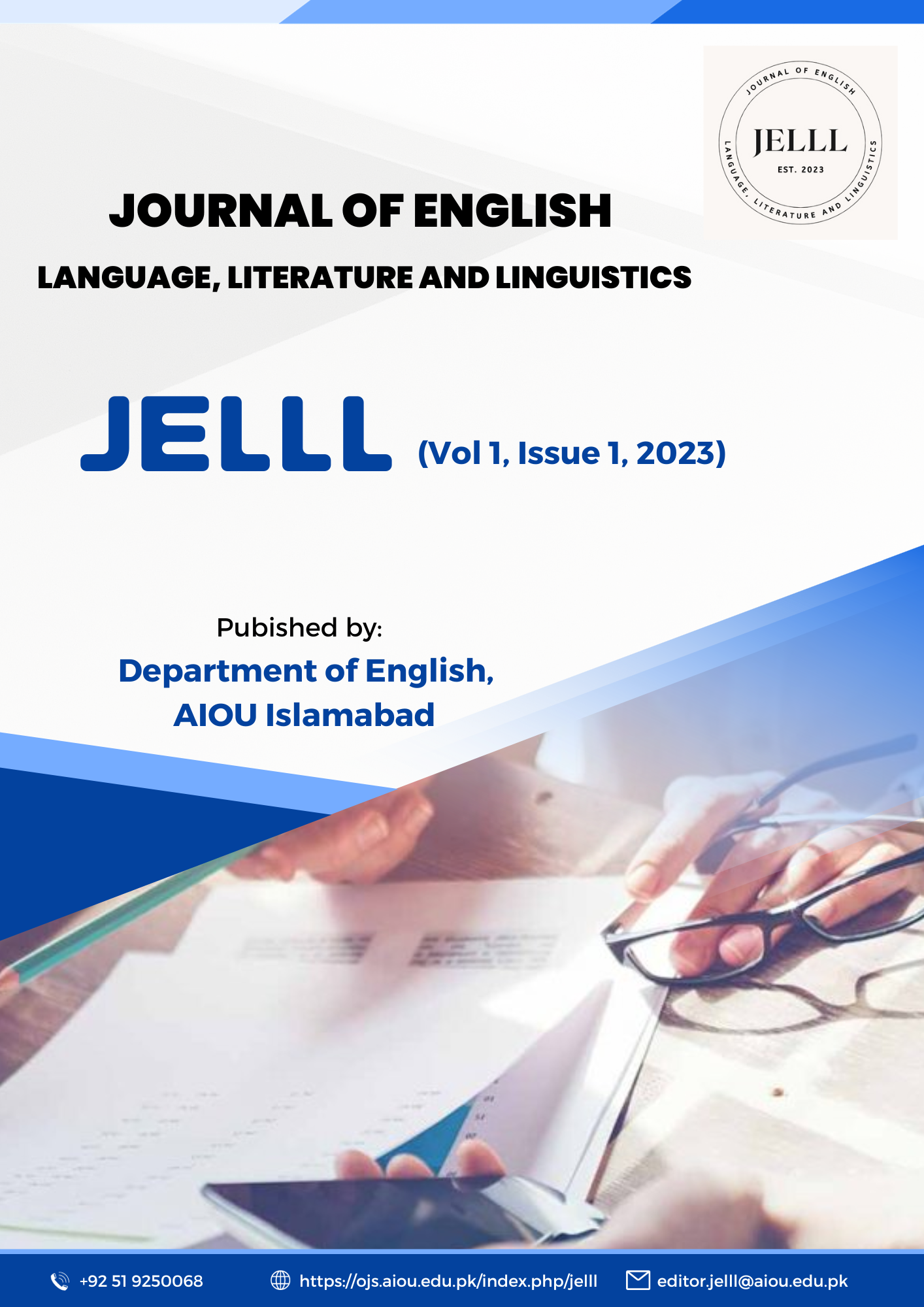A Stylistic analysis of Coke Studio’s selected English Songs
Abstract
Language is a very basic element to convey human expressions, thoughts, and emotions. Through the medium of language human beings interpret everything around them; songs are an example of language. To make the songs sound appealing to the listeners, singers may deviate from the lyrics as they sing. The focus of this study is on the semantic deviation to find out the style of the writer and to find the meaning. For this purpose, researcher chooses two English songs from Coke Studio, “I’m in Love”, and “My Happiness”. This study presents lexical parallelism, and morphological parallelism, and at the end describes the Semantic deviation. For this study stylistics is the most suitable approach, stylistics is a field of linguistics that examines the relationship between language and its artistic use in literature, music, advertisements, and other forms of expression. This study uses the semantic level, lexical level, and morphological level of stylistics for this research. The researcher used the qualitative method and content analysis for this study, and applies the stylistic analysis on the selected songs of Coke Studio. This study finds the semantic, lexical, and morphological terms from the song’s lyrics. This study also classified the terms that find in the Songs and also interpreted the meaning in terms of stylistics. This study finds out, in both songs writers used the same semantic, lexical, and morphological devices. The most occurring device in both songs is Semantic Parallelism; the interpretation of stylistic devices suggests that the theme of love is mostly explored in the song.
Downloads
References
Adawiyah, A. (2017). The Effectiveness of Popular Songs in Improving Students' Listening Skill. UIN Syarif Hidayatullah Jakarta.
Ahmed, S., Abbas, F. & Jalil, M. K. (2017). Stylistic analysis of the English translations of Surah Rehman: A comparative study of multiple sources. Al-Qalam, 22 (1), 458-467.
Batool, S., et al. (2014). "Stylistic Analysis of Robert Frost’s Poem:“The Road Not Taken”." Journal of ELT and Applied Linguistics (JELTAL), 2(4): 52-64.
Becker, J. (1986). "Is Western art music superior?" The Musical Quarterly72(3): 341-359.
Berelson, B. (1952). "Content analysis in communication research."
Booij, G. (2012). The grammar of words: An introduction to linguistic morphology, Oxford University Press.
Chaer, A. (1990). Pengantar semantik bahasa Indonesia, Rineka Cipta.
Darko, I. D., Afrifa-Yamoah, D., Djorbua, C., & Darko, C. D. (2021). A Clash of Worlds: A Stylistic Analysis of Imrana's "Imagine Say". International Journal of Language and Literary Studies , 33-40.
Dechaine, R.-M., et al. (2012). Linguistics for dummies, John Wiley & Sons.
Finegan, E. and N. Besnier (1989). "Registers: Language Variation in Situations of Use." Language: Its Structure and Use: 422-455.
Fromkin, V., et al. (2013). An introduction to language, Cengage Learning.
Gopaldas, A. (2016). "A front-to-back guide to writing a qualitative research article." Qualitative Market Research: An International Journal19(1): 115-121.
Green, L. (2006). "Popular music education in and for itself, and for ‘other’ music: current research in the classroom." International Journal of Music Education24(2): 101-118.
Gunawati, E., et al. (2017). "IMAGERY IN THE ENGLISH TRANSLATION OF WANG WEI’S POEM AN AUTUMN NIGHT, SITTING ALONE." SPHOTA: Jurnal Linguistik dan Sastra9(2): 32-38.
Holsti, O. R. (1968). "Content analysis." The handbook of social psychology2: 596-692.
Hsieh, H.-F. and S. E. Shannon (2005). "Three approaches to qualitative content analysis." Qualitative health research15(9): 1277-1288.
Kracht, M. (2007). "Introduction to linguistics." Los Angeles. LA: Hilgard Avenue.
Leech, G. N. and M. Short (2007). Style in fiction: A linguistic introduction to English fictional prose, Pearson Education.
Lo, R. S. M. and H. C. F. Li (1998). Songs Enhance Learner Involvement: Materials Development. Forum, ERIC.
MacDonald, R. and G. Wilson (2014). Musical improvisation and health: A review. Psychology of Wellbeing, 4 (20).
Mahlberg, M. (2017). Corpus stylistics. The Routledge handbook of stylistics, Routledge: 396-410.
Malik, M. A., Abbas, F., & Jawad, M. (2020). Narrative, Narrator and Narration: A structuralist and psycho-narrative reading of “The Kite Runner” by Khaled Husseini. Elementary Education Online, 19(4), 3746-3755.
McElvenny, J. (2014). "Ogden and Richards’ The Meaning of Meaning and early analytic philosophy." Language Sciences41: 212-221.
Mitchell, L., et al. (2012). Music, Health, and Wellbeing, Oxford University Press.
Semino, E. and J. Culpeper (2002). Cognitive stylistics: Language and cognition in text analysis, John Benjamins Publishing.
Sholihah, L. (2018). The meaning of semantic analysis within Songs’ lyrics, “A head full of dreams” Album by Coldplay." Lire Journal (Journal of Linguistics and Literature)2(2): 35-40.
Simpson, P. (2004). Stylistics: A resource book for students, Psychology Press.
Strauss, A. and J. Corbin (1998). "Basics of qualitative research techniques."
Syahrina, A. (2019). A Stylistic Study of Figurative Language in Katy Perry’s Song Lyrics From Witness Album, Fakultas Adab dan Humaniora UIN Syarif Hidayatullah Jakarta.
Verdonk, P. (2002). Stylistics, Oxford University Press.
Waheeb, K. A. (2017). "A pragmatic-stylistic approach to the study of dramatic texts." Journal of University of Babylon25(5): 2121-2131.
Williams, R. D. and R. Mahmood (2019). "A soundtrack for reimagining Pakistan? Coke Studio, memory and the music video." BioScope: South Asian Screen Studies10(2): 111-128.
Yule, G. (2022). The study of language, Cambridge university
Downloads
Published
How to Cite
Issue
Section
License
Authors shall retain the copyrights to the article. Author/s grant the journal an irrevocable,
non-exclusive license to publish the article electronically and in print format, and to identify
itself as the original publisher. Author(s) can grant any third party the right to use the article
freely as long as its original authors and citation details are identified. The article is
distributed under the Creative Commons Attribution 4.0 License. Unless otherwise stated,
associated published material shall be distributed under the same license.


